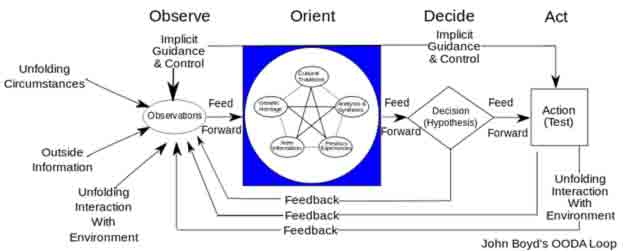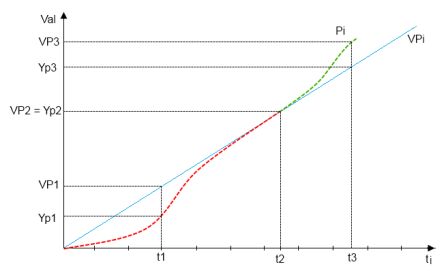Abstract
Table of contents
- Introduction
- 1. Problem definition. Research tasks and objectives
- 2. Review of current researches in goal-orientation area
- 3. Execution metrics in goal-oriented systems
- Conclusion
- References
Introduction
Current approaches to the automated systems design can be characterized as a process-oriented paradigm, when multiple individual systems automate business processes and system components are integrated with the help of middleware. Modification (eg, due to changes in the business process) and integration of such systems are difficult and costly because of the low flexibility of business processes, systems fragility and conflicts of purposes. The goal-orientation involves the study and analysis of the purpose of creating an automated system for its effective implementation and seamless integration with other systems by creating the unified approach to the automated systems design.
1. Problem definition. Research tasks and objectives
Goal-oriented approach is based on the principle of continuous multi-level management: the architecture includes control blocks that change their management strategy over time. For making decisions about changes in the control actions the up-to-date performance information is needed. Information of that type is called execution metrics.
One of the main functional blocks of a goal-oriented system is a control unit, a decision support system, which manages goals and operates with execution progress data. This data can be obtained from execution metrics. The purpose of my master's work is to develop models and algorithms for execution metrics analysis. The main objectives of the initial phase of work are the determination of applicable analysis methods and data-processing and tools that can be used as a data storage.
Scientific actuality and relevance of work are confirmed by the fact that at present there is no single universal approach to the execution metrics analysis and there are no algorithms for their processing.
2. Review of current researches in goal-orientation area
At the global level, researches and development on the goal-orientation subject were performed by University of Arizona (Arizona State University), the representatives of the Modular Mining Systems Inc. (Sergey Seroukhov, Product Line Architect, Modular Mining Systems Inc., Tucson, Arizona, USA) and Machine Guidance Systems (Andree Rottig, Product Manager, Machine Guidance Systems, Belo Horizonte, Brazil).
At the national level, the research in self-organizing systems area started Victor Glushkov (Institute of Cybernetics of USSR).
At the local level, in DonNTU, research and development in this area now are conducted by prof. Yuriy Skobtsov, assoc.prof. Maxim Privalov, assoc.prof. Vadim Skobtsov, Assoc.prof. Alexander Telyatnikov.
3. Execution metrics in goal-oriented systems
3.1 OODA loop in goal-oriented MAS
In general, goal is a condition to which the tendency of object transforming is directed. It usually arises from a specific problem situation. The system serves to solve the problem: carrying out its functions with the use of certain structures, the system provides a solution [1]. There's no system without a goal and goal is the main reason for the group of elements to integrate into the system and act. The goal of the system is set from outside, and the system should only fulfill this goal. External goal-setting action may be performed by another system (or systems) [2]. Based on this principle, we can represent the system as a set of subsystems. Each of them has its own goals at a lower level and its own subsystems. Goals levels:
- policies, laws and regulations, the most high-level goals;
- long-term goals, strategic initiatives, organization structuring, organization mechanisms forming;
- short-term goals: typical projects, daily activities of the organization;
- operational: dispatching, resource management, acting in situations of emergency;
- specific operations at the resource level.
In management theory the decomposition of goal by building a tree is well discussed. Building a goal tree is a method to systematize goals and acts [3]. In the process of constructing the main goal of the tree is divided into sub-goals, and this process is repeated iteratively, until the terminal nodes of the tree are represented by elementary steps. An example of such a structure is shown in the figure below.

Figure 1. Goal Tree
(animation: 7 frames, 5 cycles of repeating, 24 kB)
(Gi — composite goals, Ai — elementary actions)
The work of a goal-oriented system as a whole and of each of its components is a continuous OODA management cycle. It consists of four stages: observation, orientation, decision, action [4].

Figure 2. OODA Loop
OODA-loop is a concept originally applied in military at the strategic level of military operations, but over time it has found its application in the economics (the SWOT method of strategic planning — Strengths & Weaknesses / Opportunities & Threats) and science (hypothesis — experiment — evaluation methodology). Such a cycle is typical for any control process in cybernetics.
In goal-oriented automated system the stage of observation corresponds to the collection of system information, the stage of orientation corresponds to the definition of the problem, the solution phase (decide) is for planning further actions, and the stage of action complies with all the operations of the system, performed in accordance with the decision. The information about the operations is then transferred to the analysis subsystem as observations, providing feedback.
Regardless of the automation level of decision-making entities, their activities are based on information on the goals progress and state, which is why execution metrics analysis is the main tool for planning and forecasting goals progress.
3.2 Execution planning and forecasting
Planning is a future-oriented decision-making activities, which include the assignment and the selection of behaviors. It is related to the achievement of the desired future state, and addresses the question of what should be done and to what degree this is due to the proposed activity. The complexity of the planning and decision-making is to achieve a compromise between long-term (strategic) and short-term (tactical) objectives. It includes a reasonable choice of alternatives and resources to achieve the objectives [6]. The historical data is a basis to build the execution forecast.
The problem of forecasting in goal-oriented systems is described by two basic task types: forecasting time to achieve a goal and making the prediction of parameters values at a given moments in time. Mathematical model of metrics analysis can be represented as follows: assume that
- P = {p1, p2, ..., pN} is an observed parameters set;
- N is number of parameters;
- YP1 .. N = {Yp1, Yp2, ..., YpN} is a set of time series describing the change of parameters P, where
- Ypi1 .. ni = {ypi1, ypi2, ..., ypini} is a set of consecutive measurements values of Pi at time points from 1 to ni (ni, in general, differs for each Pi);
- VP = {VP1, VP2, ..., VPN} is a target values set, where
- VPi = {VPi1, VPi2, ... VPini + h} is the target values set of the parameter Pi;
- tg = {tP1g, tP2g, ..., tPNg} is target time to achieve the VP;
- tr = {tP1r, tP2r, ..., tPNr} - is real time to achieve VP;
- tp = {tP1p, tP2p, ..., tPNp} - the predicted time to achieve the VP.
- Ypini +1 .. hi = {ypini +1, ypini +2, ..., ypini + hi} is the forecast for the parameter Pi for periods of hi (hi, in general, is different for each Pi).

Figure 3. The progress of parameter change
The control system aims to reduce the difference between predicted and target values of the parameters:
 in case of predicted parameter values or
in case of predicted parameter values or
 in case of predicted time to achieve the goal.
in case of predicted time to achieve the goal.
Execution metrics are continuously accumulated in the system as information, that characterizes its state at different times. They can be represented in the form of time series of observed parameters, which a descision-making entity is focused on. Therefore, to make decisions on the basis of these data the methods of time series analysis and forecasting are applicable .
In statistics, a time series is a sequence of data points, measured typically at successive time instants spaced at uniform time intervals. Time series includes two required elements, time stamp and value [7], which is in our case the metric value.
The task of forecasting is successfully solved by methods of mathematical statistics and data mining tools, among which the neural networks (NN) and decision trees are the most frequently used ones.
Conclusion
Goal-orientation represents the new approach to the design and implementation of the management automation systems. Execution metrics are the parameters of the system used to evaluate progress to achieve goals. Since the information about changing of these parameters can be represented as time series, all known methods of time series analysis and forecating are applicable.
Note
At the moment master's work is not complete yet. Final completion date: December 2012. The full text of the work and its materials can be obtained from the author or her scientific adviser after that date.
References
- 1. Сурмин Ю.П. Теория систем и системный анализ: Учеб. пособие. / Сурмин Ю.П. — К. : МАУП, 2003. — 368 с.
- 2. Теория систем и системный анализ в управлении организациями: Справочник: Учеб. пособие / Под ред. В.Н.Волковой и А.А.Емельянова. — М. : Финансы и статистика, 2006 p. — 848 с.
- 3. Долятовский В.А. Исследование систем управления: Учебно-практическое пособие. / В.А.Долятовский, В.Н.Долятовская — М. : ИКЦ "Март", 2003. — 256 c.
- 4. McElman, C. From Buttons to Bits — Achieving Level 3 Integration. Paper 4383, APCOM 2009 conference, Vancouver BC, Oct. 2009. / C. McElman, S. Seroukhov // [Электронный ресурс]. — Режим доступа: www/URL: http://www.mmsi.com/files/download/TechPapers/McElman_Seroukhov_APCOM_2009.pdf.
- 5. Бесекерский В.А. Теория систем автоматического управления. / В.А.Бесекерский, Е.П.Попов — СПб. : Профессия, 2003 p. — 751 с.
- 6. Саати Т. Аналитическое планирование. Организация систем; пер. с англ. / Т. Саати, К. Керис — М. —: Радио и связь, 1991 p. — 224 c.
- 7. Чураков Е.П. Прогнозирование эконометрических временных рядов: Учеб. пособие / Чураков Е.П. — М. : Финансы и статистика, 2008 г. — 208 c.
